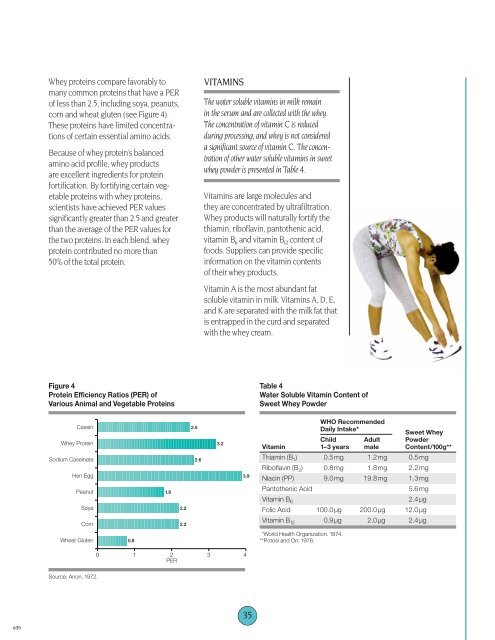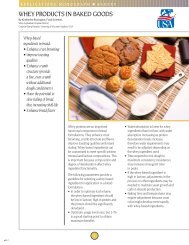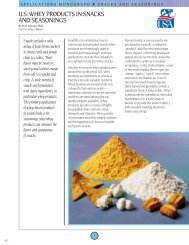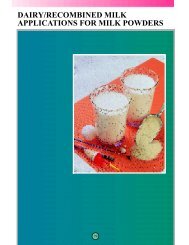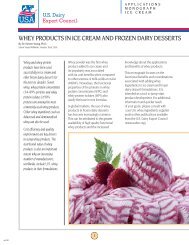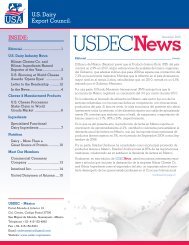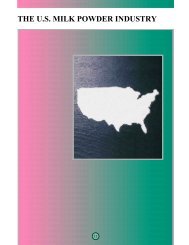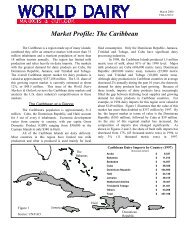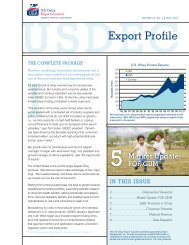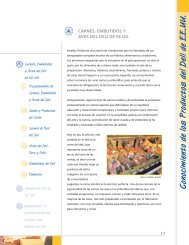nutritional and functional properties of whey and lactose
nutritional and functional properties of whey and lactose
nutritional and functional properties of whey and lactose
You also want an ePaper? Increase the reach of your titles
YUMPU automatically turns print PDFs into web optimized ePapers that Google loves.
Whey proteins compare favorably to<br />
many common proteins that have a PER<br />
<strong>of</strong> less than 2.5, including soya, peanuts,<br />
corn <strong>and</strong> wheat gluten (see Figure 4).<br />
These proteins have limited concentrations<br />
<strong>of</strong> certain essential amino acids.<br />
Because <strong>of</strong> <strong>whey</strong> protein’s balanced<br />
amino acid pr<strong>of</strong>ile, <strong>whey</strong> products<br />
are excellent ingredients for protein<br />
fortification. By fortifying certain vegetable<br />
proteins with <strong>whey</strong> proteins,<br />
scientists have achieved PER values<br />
significantly greater than 2.5 <strong>and</strong> greater<br />
than the average <strong>of</strong> the PER values for<br />
the two proteins. In each blend, <strong>whey</strong><br />
protein contributed no more than<br />
50% <strong>of</strong> the total protein.<br />
VITAMINS<br />
The water soluble vitamins in milk remain<br />
in the serum <strong>and</strong> are collected with the <strong>whey</strong>.<br />
The concentration <strong>of</strong> vitamin C is reduced<br />
during processing, <strong>and</strong> <strong>whey</strong> is not considered<br />
a significant source <strong>of</strong> vitamin C. The concentration<br />
<strong>of</strong> other water soluble vitamins in sweet<br />
<strong>whey</strong> powder is presented in Table 4.<br />
Vitamins are large molecules <strong>and</strong><br />
they are concentrated by ultrafiltration.<br />
Whey products will naturally fortify the<br />
thiamin, rib<strong>of</strong>lavin, pantothenic acid,<br />
vitamin B 6 <strong>and</strong> vitamin B 12 content <strong>of</strong><br />
foods. Suppliers can provide specific<br />
information on the vitamin contents<br />
<strong>of</strong> their <strong>whey</strong> products.<br />
Vitamin A is the most abundant fat<br />
soluble vitamin in milk. Vitamins A, D, E,<br />
<strong>and</strong> K are separated with the milk fat that<br />
is entrapped in the curd <strong>and</strong> separated<br />
with the <strong>whey</strong> cream.<br />
Figure 4<br />
Protein Efficiency Ratios (PER) <strong>of</strong><br />
Various Animal <strong>and</strong> Vegetable Proteins<br />
Table 4<br />
Water Soluble Vitamin Content <strong>of</strong><br />
Sweet Whey Powder<br />
Casein<br />
Whey Protein<br />
Sodium Caseinate<br />
Hen Egg<br />
Peanut<br />
Soya<br />
Corn<br />
1.8<br />
2.2<br />
2.2<br />
2.5<br />
2.6<br />
3.2<br />
3.9<br />
WHO Recommended<br />
Daily Intake*<br />
Sweet Whey<br />
Child Adult Powder<br />
Vitamin 1–3 years male Content/100g**<br />
Thiamin (B 1 ) 0.5mg 1.2mg 0.5mg<br />
Rib<strong>of</strong>lavin (B 2 ) 0.8mg 1.8mg 2.2mg<br />
Niacin (PP) 9.0mg 19.8mg 1.3mg<br />
Pantothenic Acid<br />
5.6mg<br />
Vitamin B 6<br />
2.4µg<br />
Folic Acid 100.0µg 200.0µg 12.0µg<br />
Vitamin B 12 0.9µg 2.0µg 2.4µg<br />
Wheat Gluten<br />
0.8<br />
*World Health Organization. 1974.<br />
**Potosi <strong>and</strong> Orr. 1976.<br />
0<br />
1<br />
2<br />
PER<br />
3<br />
4<br />
Source: Anon. 1972.<br />
e35<br />
35


